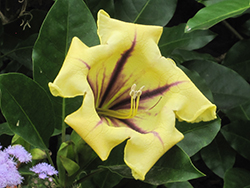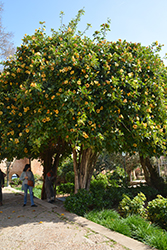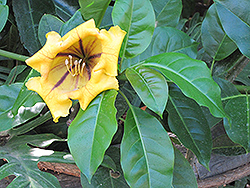Fri & Sat 8am - 8pm
Sun 8am - 7pm
Anytown, USA 12345
fax: 261.787.0463
e-mail: info@successgc.com


Plant Finder

Height: 25 feet
Spread: 4 feet
Sunlight:
![]()
![]()
Hardiness Zone: 9b
Other Names: Golden Chalice Vine, Hawaiian Lily, S. nitida
Description:
A large evergreen vine that climbs with support, featuring thick, elliptical leaves on sturdy stems; enormous, fragrant, trumpet-shaped golden flowers from mid-winter into spring; perfect for garden walls or arbors; protect from frost
Ornamental Features
Cup of Gold Vine features showy fragrant buttery yellow trumpet-shaped flowers with yellow overtones and deep purple stripes at the ends of the branches from mid winter to late spring. It has attractive dark green evergreen foliage which emerges light green in spring. The large glossy oval leaves are highly ornamental and remain dark green throughout the winter.
Landscape Attributes
Cup of Gold Vine is a dense multi-stemmed evergreen woody vine with a twining and trailing habit of growth. Its relatively coarse texture can be used to stand it apart from other landscape plants with finer foliage.
This woody vine will require occasional maintenance and upkeep, and should only be pruned after flowering to avoid removing any of the current season's flowers. It is a good choice for attracting bees and butterflies to your yard, but is not particularly attractive to deer who tend to leave it alone in favor of tastier treats. It has no significant negative characteristics.
Cup of Gold Vine is recommended for the following landscape applications;
- Accent
- Mass Planting
- Hedges/Screening
- General Garden Use
- Container Planting
Planting & Growing
Cup of Gold Vine will grow to be about 25 feet tall at maturity, with a spread of 4 feet. As a climbing vine, it tends to be leggy near the base and should be underplanted with low-growing facer plants. It should be planted near a fence, trellis or other landscape structure where it can be trained to grow upwards on it, or allowed to trail off a retaining wall or slope. It grows at a medium rate, and under ideal conditions can be expected to live for 60 years or more.
This woody vine does best in full sun to partial shade. It does best in average to evenly moist conditions, but will not tolerate standing water. It is not particular as to soil type or pH, and is able to handle environmental salt. It is highly tolerant of urban pollution and will even thrive in inner city environments. This species is not originally from North America, and parts of it are known to be toxic to humans and animals, so care should be exercised in planting it around children and pets.
Cup of Gold Vine makes a fine choice for the outdoor landscape, but it is also well-suited for use in outdoor pots and containers. Because of its spreading habit of growth, it is ideally suited for use as a 'spiller' in the 'spiller-thriller-filler' container combination; plant it near the edges where it can spill gracefully over the pot. It is even sizeable enough that it can be grown alone in a suitable container. Note that when grown in a container, it may not perform exactly as indicated on the tag - this is to be expected. Also note that when growing plants in outdoor containers and baskets, they may require more frequent waterings than they would in the yard or garden.


